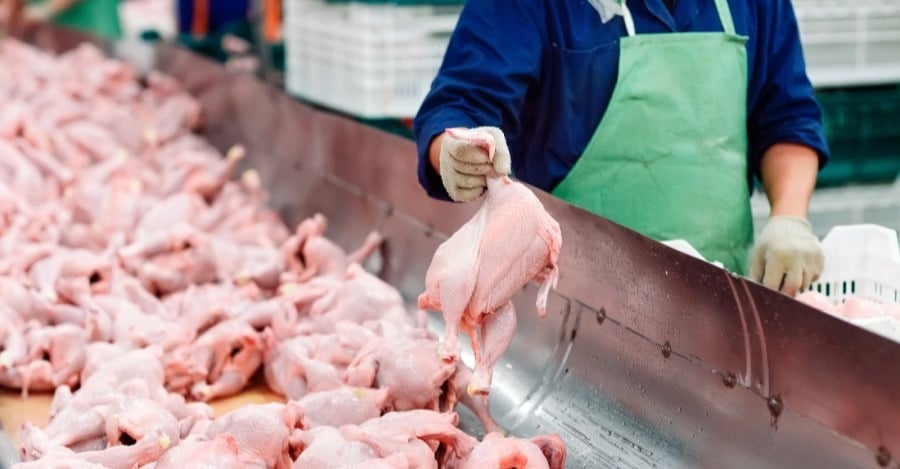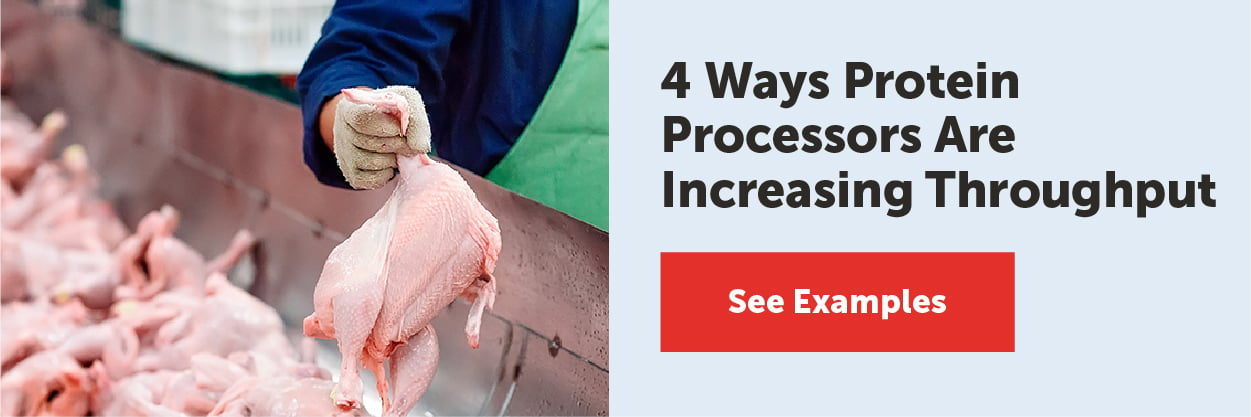If you are looking for inspiration, this guide looks at some real-life examples of how protein processors are leveraging new techniques to achieve tangible gains in production throughput, efficiency, cost, and product quality. As you’ll see below, these improvements are applicable to a variety of product categories, including pork, chicken, beef, meat alternatives, and IQF products.
4 Ways to Improve Protein Processing Effectiveness
- Use liquid nitrogen to speed up bottom injection (BI) chilling.
- Upgrade freezer technology to increase throughput.
- Leverage liquid nitrogen to streamline production lines.
- Ensure consistent chill temperatures to keep forming equipment “smear-free.”
We explore each of these methods in detail below. If you are interested in the specifics of any of these applications, we include a link to a more in-depth case study for each one.
Use Liquid Nitrogen to Speed Up Bottom Injection Chilling
By replacing carbon dioxide (CO2) with liquid nitrogen (LIN) for bottom injection chilling, protein processors can eliminate the extra mixing time required to sublimate solid CO2 particles. And for processors working to run near max capacity, any reductions in cycle time can mean more pounds per hour out the door. Wolverine Packing Co., a Detroit-based meat processor, is one of over 60 installations that worked with Messer to implement LIN-based bottom injection chilling for their number one product, ground beef. Leveraging patented hygienic KRYOJECTOR® injectors, Wolverine has achieved a post-chill processing time reduction of at least 30 seconds per batch. Multiplied over average daily production of over 100 batches of ground beef, this time savings translated to an additional 50 minutes of extra processing time per day—or 30,000 lbs/day of added mixer processing capacity.
You can learn more about this solution in our case study here (including how the new LIN system also delivered key food safety advantages).
Use Liquid Nitrogen to Speed Up Bottom Injection Chilling
For processors working to scale up frozen food production lines, limitations on freezing capacity can represent an important potential bottleneck. Space restrictions, however, mean that simply adding a larger freezer is not always a viable (or cost-effective) option. Kayem Foods, the largest meat processor in New England, began encountering these freezing capacity constraints as they scaled up production of popular new al fresco chicken sausages.
After consulting with Messer, Kayem made the decision to upgrade from a cryogenic tunnel freezer to a cryogenic impingement freezer. Messer’s impingement freezer design offers significantly higher capacity compared to a traditional cryogenic tunnel freezer with the same footprint and low unit operating costs due to efficient use of the cryogen.
The upgraded freezer was able to effectively double the production line’s freezing capacity, while taking up about the same amount of space as the previous solution.
You can learn more about this application in our case study here.
Leverage Liquid Nitrogen to Streamline Production Lines
The increased production capacity enabled by liquid nitrogen freezing/chilling can offer synergistic benefits for the entire production line. Tip Top Poultry, a major supplier of IQF chicken products, demonstrates how (you can learn more details in the case study here).
LIN offered a number of advantages over CO2, which required snow buildup to be cleaned out at regular intervals, often several times a shift. By replacing three CO2 flighted freezers with a single Messer wave freezer, Tip Top was able to streamline production to a single scale and bagger as well. The ability to run through a single system, explains Tip Top plant manager Curt McNiff, “results in a reduction of operational and sanitation labor.”
Ensure Consistent Chill Temperatures to Keep Forming Equipment “Smear-Free”
In addition to allowing for higher throughput, quicker chill times result in a shorter mixing time, which means less “beat up” meat and less emulsified fat. The result, notes Interstate Meat Distributors President Darrin Hoy, is a product that “looks better in the package too.”
In this case study, you can learn more about how Interstate became the first meat processor in North America to begin using bottom-injection nitrogen chilling.
In addition to reducing chill time in the blender from eight minutes to three, Messer’s nitrogen bottom injection system equilibrates each batch to a specific target temperature. Consistent chill temperatures help forming equipment run smoothly and smear-free.
Learn More About Options for Streamlined Protein Processing
The solutions discussed above can often be implemented in a matter of weeks, which means they offer valuable strategic flexibility. Investments in new facilities or production lines can take months, or even years, to generate additional production capacity.
But improvements like LIN-powered chilling can help overcome production shortfalls on a far shorter timeline (without any major disruptions to the current production process).
The applications discussed here are just a few ways protein processors can make
improvements to their production line. If you’re interested in discussing your options, we encourage you to contact the Messer food processing team. We can provide advice and/or a complimentary production process assessment.




Comments
Messer makes no warranty of any kind with respect to the subject matter, the completeness, or accuracy of this blog. Messer is not responsible for any actions (or lack thereof) taken as a result of relying on or in any way using information contained in this blog. In no event shall Messer be liable for any damages resulting from reliance on or use of information in this blog. Readers should take advice from a qualified professional when dealing with specific situations. Descriptions of, or references or access to, other publications within this blog do not imply endorsement of those publications. This blog may contain technical inaccuracies and changes to the information may be made at any time.
Gas products are hazardous. The use or misuse of gas products involves serious risks, including injury, disability and death. Users of gas products must use the Safety Data Sheets for the gas products to warn their employees and others who are exposed to the gas products or hazards associated with such products.